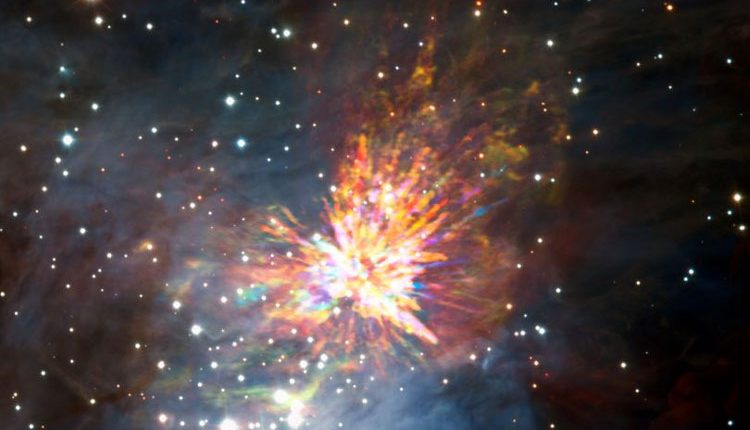Aftermath of star birth caught on camera
The debris left behind after stars were born in dramatic explosions has been caught on camera.
Using the Atacama Large Millimeter/submillimeter Array (Alma), a group of astronomers has studied the aftermath from an explosive event when two young stars grazed past each other.
Stars form when huge clouds of dust and gas, known as protostars, collapse under their own weight. Thousands of years ago, two protostars in the Orion Molecular Cloud 1 (OMC-1), 1,500 light years away, orbited close to one another.
This triggered an eruption, launching nearby protostars and giant streams of dust far into interstellar space. The explosion released as much energy as our Sun emits over the course of 10 million years, firing gas at speeds of up to 150km/h.
Now, the leftover debris can be seen from Earth.
“What we see in this once calm stellar nursery is a cosmic version of a 4th of July fireworks display, with giant streamers rocketing off in all directions,” said Lead Author John Bally from the University of Colorado.
Explosions like this are expected to be relatively short, with remnants lasting only centuries – an incredibly short time compared to the age of the Universe.
“Though fleeting, protostellar explosions may be relatively common,” continued Bally. “By destroying their parent cloud, as we see in OMC-1, such explosions may also help to regulate the pace of star formation in these giant molecular clouds.”
In 2009 astronomers using the Submillimeter Array in Hawaii caught the first glimpse of the explosion, but ALMA provided much more clarity on the explosion. It uncovered important details about the distribution and motion of carbon monoxide gas inside the streams. This helps us understand the force of the blast and the impact events like this have on how stars form.
“The explosion released as much energy as our Sun emits over the course of 10 million years, firing gas at speeds of up to 150 km/h.”
“People most often associate stellar explosions with ancient stars, like a nova eruption on the surface of a decaying star or the even more spectacular supernova death of an extremely massive star,” Bally added. “Alma has given us new insights into explosions on the other end of the stellar life cycle, star birth.”


Comments are closed, but trackbacks and pingbacks are open.